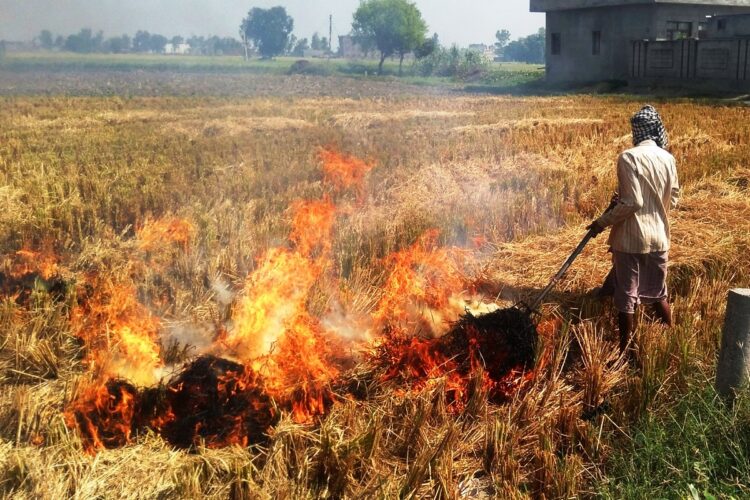In 5 years, the Uttar Pradesh government reports a 65% decrease in incidents of Stubble Burning
Within a five-year period, from 2017 to 2022, Uttar Pradesh had a staggering 65.65% drop in stubble burning, which is in line with the Center’s goal of achieving zero paddy stubble burning events in the current season.

This was accomplished at a time when efforts are being made to stop crop burning in north India. To make the goal a reality, the Center is now distributing cash to Punjab, Haryana, Uttar Pradesh, and Delhi under the Crop Residue Management (CRM) plan. These are the four states where stubble burning is considered to be a major source of environmental damage each winter.
Before going into the specifics of the development, here is a brief explanation of stubble burning and the reasons why it must be banned in order to preserve our natural environment.
Burning leaves is a serious environmental issue.
In order to cleanse the fields before planting the seeds for winter crops a few weeks later, stubble burning is simply the act of putting the straw stubble remains on fire following the harvesting of rice. During the months of October and November, burning stubble is a well-known agricultural practice in Punjab, Haryana, and Uttar Pradesh.
The massive quantity of smoke that is released during stubble burning, along with air pollution from nearby traffic and a decrease in wind speed, causes the production of a thick layer of smog that covers the national capital area every winter.
Due to deteriorated air quality throughout the pre-winter and winter seasons, physicians across the nation have seen a significant increase in the number of patients with severe respiratory diseases in recent years. Asthma and Coronary Obstructive Pulmonary Disease (COPD), which are directly linked to exposure to toxic and dirty air, are two conditions that commonly make the list of illnesses.
Burning stubble has a negative impact on the air quality index (AQI), as well as the health and fertility of the soil by diminishing the levels of soil humus and fossil content. Additionally, it causes soil enzyme levels and microbial population decline.
What is the official announcement about the UP’s status?
The Uttar Pradesh administration praised the state’s achievement in reducing occurrences of stubble burning by 65.65% between 2017 and 2022 in a statement released on September 21.
An elaborate presentation that reportedly highlighted all the data related to the Promotion of Agricultural Mechanization for In-Situ Management of Crop Residue (CRM) scheme for the financial year 2022 was made before Chief Secretary Durga Shankar Mishra in an effort to clarify the situation.
According to the presentation, there were 3,017 cases of agricultural residue burning in total in 2022, a dramatic fall of 65% from the 8,784 events in 2017.
The agricultural department of Uttar Pradesh has also taken the initiative of giving trash decomposers to paddy crop producers in an effort to lessen the negative environmental effects of stubble burning. According to media sources, the distribution of more than 18 lakh decomposer kits has already started.
UP Government directions
The burning of agricultural residue has been prohibited by further orders issued by the chief secretary of Uttar Pradesh.
According to reports, the agricultural department has been tasked with organizing thorough awareness and public relations campaigns using IEC (Information, Education, and Communication) programs.
The instructions included information on the value of using print media for publicity and putting awareness campaigns into action at many levels, including district and Nyaya Panchayat levels. Additionally, it was clear that the awareness-raising effort included radio jingles, television audio-visual snippets, and scrolling messaging on TV.
The instructions included the need for teams to be formed at many levels, including the village, Nyaya Panchayat, developmental block, tehsil, and district, to collaborate in educating and involving the people.
The alternative story
While the state administration brags about the reduction in occurrences of stubble burning, the report from the previous year provided a different perspective by listing 18 districts that failed the stubble burning test, according to UP chief secretary Durga Shanker Mishra. Aligarh, Barabanki, Fatehpur, Kanpur Nagar, Mathura, Hardoi, Sambhal, Ghaziabad, Gautam Budh Nagar, Meerut, Saharanpur, Rampur, Kheri, Pilibhit, Shahjahanpur, Bulandshahr, Shamli, and Bareilly are among the districts included.
According to a study from the previous year, the state government’s examination did not reveal the projected drop in stubble burning incidences in those 18 districts.
Another study from the previous year said that the number of incidents of stubble burning in Uttar Pradesh had directly increased. According to the data, there have been 80 crop burning incidents reported in Uttar Pradesh as of October 6 in 2022, compared to 52 in 2021. There were 101 recorded occurrences in 2020.







